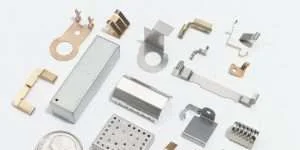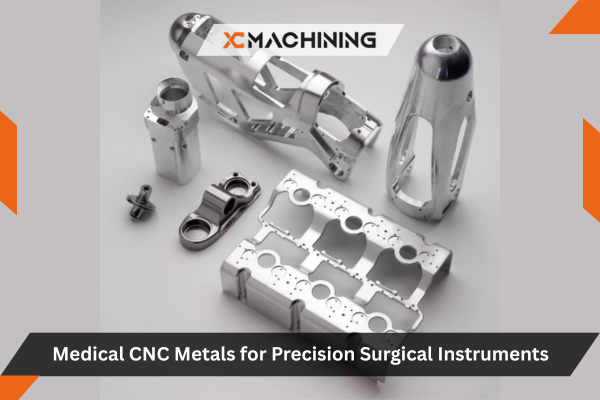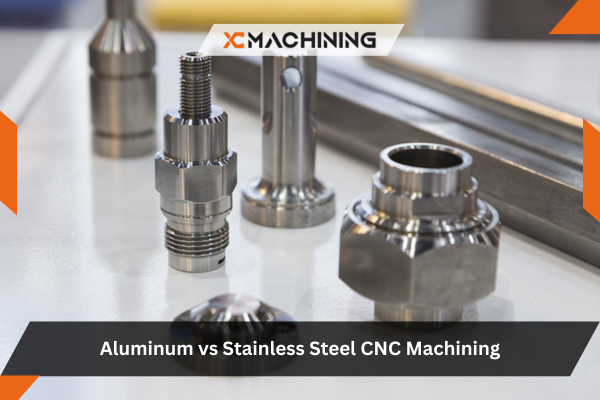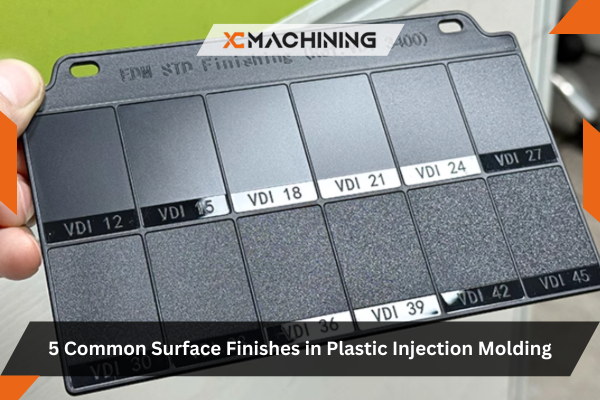La création d'un prototype est une étape initiale et cruciale dans le processus de développement d'un produit. Grâce aux prototypes métalliques, les ingénieurs peuvent trouver les défauts ou les imperfections de leurs idées avant la production en série.
Il existe différentes méthodes pour réaliser des prototypes métalliques. Toutes ces méthodes présentent des avantages et des inconvénients uniques. Ces méthodes aident les fabricants à suivre la bonne approche pour créer des pièces métalliques innovantes. Dans cet article, vous découvrirez comment créer un prototype à l'aide de différentes méthodes.
Pourquoi choisir les prototypes métalliques ?
La sélection des matériaux est une étape cruciale pour la création de prototypes. Les plastiques, les résines, les céramiques, le bois, les métaux et bien d'autres matériaux sont couramment utilisés pour l'usinage des prototypes. Mais le métal présente de nombreux avantages par rapport à toutes ces options. Les prototypes en métal sont un bon choix pour les essais fonctionnels pour différentes raisons, dont les suivantes

Solidité et durabilité
Grâce à leur solidité et à leur durabilité, les prototypes en métal peuvent résister aux forces extérieures sans subir de dommages permanents. Alors que de nombreux prototypes en plastique ne peuvent conserver leur structure et leurs performances au fil du temps. En outre, le métal peut également résister à l'impact des environnements difficiles et aux variations de température.
Polyvalent
L'aluminium, l'acier, le titane, le cuivre ou le laiton sont les différents métaux qui peuvent être utilisés pour le prototypage. Cette polyvalence permet aux ingénieurs de choisir le meilleur métal en fonction de leurs besoins. En outre, les métaux sont également adaptés à la formation de géométries complexes.
Tests réalistes
Les prototypes métalliques permettent d'obtenir des résultats d'essais plus précis, car ils reproduisent fidèlement le produit final. Les métaux peuvent résister à la pression pendant les différentes phases d'essai sans usure ni déformation. Ces prototypes permettent donc de détecter des défauts potentiels dès le début du processus de développement.
Rentabilité
En général, le plastique est un matériau moins cher que le métal pour les prototypes. Cependant, les prototypes en métal peuvent devenir une option plus rentable pour vous, car vous n'avez pas besoin de les refabriquer sans cesse. Les prototypes métalliques sont adaptés aux applications soumises à de fortes contraintes et peuvent être testés à plusieurs reprises sans se dégrader.
Différentes méthodes pour réaliser un prototype en métal
Il existe différentes options pour faire un prototype métallique. Dans diverses industries, le processus de développement implique des exigences et des complexités différentes. Voici les principales méthodes de fabrication de prototypes métalliques.

Prototype d'usinage CNC
L'usinage CNC fonctionne selon les instructions de machines commandées par ordinateur. La CAO donne des instructions au contrôleur de la CNC pour commander le mouvement de l'équipement afin de former un prototype métallique.
Il existe différents types d'usinage CNC, dont les 3 axes, les 4 axes et les 2 axes. CNC à 5 axes . Les machines CNC dotées d'un plus grand nombre d'axes peuvent effectuer des tâches plus complexes. Le choix d'une machine CNC dépend donc de la complexité des pièces ou des opérations d'usinage.
Avantages et inconvénients de l'usinage CNC
Le Usinage CNC offre une grande précision, une grande répétabilité et la possibilité de créer des formes complexes. Il offre également des délais d'exécution rapides et permet de travailler avec une large gamme de matériaux.
Cependant, les coûts d'installation initiaux sont élevés et des opérateurs qualifiés sont nécessaires. En outre, le processus peut produire des déchets et des déchets de fabrication. nécessitent un entretien régulier.

Impression 3D d'un prototype en métal
3D impression du métal est une méthode moderne de fabrication de prototypes métalliques. Elle diffère de l'usinage CNC car il s'agit d'une méthode de fabrication additive. Ce procédé permet de créer des pièces métalliques couche par couche en utilisant de la poudre métallique.
La poudre métallique forme une fine couche sur la plate-forme de construction et le faisceau d'électrons sépare les couches. Ce processus se poursuit jusqu'à ce que le produit entier soit formé. Impression 3D est adapté à la fabrication de pièces métalliques légères, complexes, à usage unique ou temporaires.
Avantages et inconvénients de l'impression 3D
Avec l'impression 3D, il est facile de créer des modèles complexes. Elle permet également de réduire les délais d'exécution par rapport à l'usinage CNC. Mais elle ne donne pas aux prototypes une finition de surface lisse. C'est une méthode coûteuse en raison de l'utilisation de poudre métallique et du post-traitement du produit.

Moulage sous pression de métaux
Le moulage sous pression du métal permet de créer des pièces complexes à l'aide d'une cavité de moule. Dans cette méthode, le métal en fusion est transféré dans une cavité de moule et, après refroidissement, il prend la forme d'un prototype. Il s'agit d'une méthode efficace pour produire des composants complexes dans différentes industries. Cette méthode permet de produire avec précision diverses pièces dans le cadre d'une production de masse.
Avantages et inconvénients du moulage sous pression
Le moulage des métaux permet la production rapide de composants complexes avec précision. Il s'agit d'une méthode rentable et plus rapide pour former des prototypes métalliques.
Toutefois, cette méthode peut s'avérer coûteuse pour les pièces complexes, car elle nécessite des matrices spéciales et des investissements importants. Un autre inconvénient est la porosité et les problèmes de surface. Ces problèmes peuvent affecter la solidité et l'esthétique du prototype, ce qui nécessite des coûts supplémentaires pour y remédier.

Prototypage de tôles
Le prototypage de tôles se déroule en trois étapes : découpe, pliage et mise en forme d'une tôle pour produire un prototype. À l'aide d'un logiciel de CAO, les ingénieurs élaborent une conception en 2D ou en 3D. Après avoir sélectionné le métal en fonction des exigences, d'autres opérations sont effectuées sur la tôle pour créer le prototype métallique souhaité.
Avantages et inconvénients de la fabrication de tôles
Le prototypage de tôles accélère le processus de développement des produits. Il est également moins coûteux que les autres méthodes traditionnelles. Il convient donc aux projets à faible coût et à exécution rapide.
Cependant, il est difficile, voire impossible, de réaliser des formes complexes, car la fabrication de tôles repose uniquement sur la découpe et le pliage.

Extrusion de métal
L'extrusion du métal consiste à forcer le métal à travers une filière pour créer la forme souhaitée. Lorsque le métal passe à travers la filière d'extrusion, il produit des profils de section transversale fixes ou des pièces. Au cours de ce processus, le métal est soumis à des contraintes de compression et de cisaillement pour obtenir la forme souhaitée. Ces forces peuvent mouler le métal dans n'importe quelle forme.
Avantages et inconvénients de l'extrusion métallique
C'est une méthode rentable car elle évite le gaspillage de métal. Presque tous les prototypes produits par cette méthode ne nécessitent pas d'usinage ultérieur car elle donne des résultats satisfaisants.
Cependant, elle n'est pas adaptée aux matériaux fragiles et peut entraîner des déformations en raison des forces de compression.
Métaux typiques adaptés au prototypage
Les métaux sont polyvalents et possèdent des propriétés uniques. C'est la raison pour laquelle ils font partie de différentes industries manufacturières. Voici quelques métaux considérés comme adaptés au prototypage métallique.
Aluminium
L'aluminium est un métal couramment utilisé dans diverses industries pour produire des prototypes. Il est utile pour produire des composants légers dans les secteurs de l'aérospatiale et de l'automobile. Prototypes en aluminium sont durables et rentables.
Acier
L'acier est un métal solide et robuste qui lui permet de supporter des charges. La solidité de l'acier le rend adapté à la construction, aux machines ou à l'industrie automobile.
Laiton
Ce métal convient aux composants électriques en raison de sa bonne conductivité électrique. Il s'agit d'un matériau polyvalent, très facile à usiner et qui peut répondre aux spécifications requises.
Titane
Le titane convient au prototypage parce qu'il est solide et léger. Ces propriétés sont idéales pour les applications qui nécessitent de la résistance sans ajouter de poids au produit.
Cuivre
Le cuivre convient aux prototypes électroniques en raison de sa conductivité thermique et électrique. Il est également malléable, ce qui permet de le façonner facilement pour obtenir un design complexe.

Conseils pratiques d'usinage pour la création de prototypes métalliques
Il est nécessaire de suivre quelques conseils d'usinage pour obtenir un prototype rapide en métal de haute qualité. Ces conseils permettent aux ingénieurs et aux concepteurs d'obtenir les prototypes souhaités.
Sélection des matériaux
Le choix du matériau approprié est nécessaire à la réussite globale du prototype métallique. Il a un impact sur les performances et la fonctionnalité du prototype. Le choix du métal dépend des propriétés mécaniques et de la conductivité thermique. Vous devez également savoir si le métal choisi est compatible ou non avec l'application envisagée.
L'industrie automobile a besoin de matériaux légers, comme l'aluminium, pour créer différents composants tels que des roues ou des panneaux de carrosserie, en raison de leur rapport poids/résistance. Le choix des matériaux a une incidence sur la consommation de carburant et les performances globales du véhicule.
CAD- Design
Le modèle de CAO (conception assistée par ordinateur) est essentiel pour produire un prototype précis. L'ensemble du processus de prototypage en dépend car il permet d'obtenir les dimensions et les fonctionnalités souhaitées pour le prototype.
Les logiciels de CAO sont faciles à utiliser pour fabriquer des prototypes métalliques de haute qualité, car ils permettent d'étudier et de diagnostiquer facilement les problèmes liés à la conception des prototypes. Par exemple, si vous devez apporter des modifications à la conception du prototype, il n'est pas nécessaire de repartir de zéro, mais vous pouvez facilement modifier la conception existante.
Sélection des outils
La sélection des outils est également nécessaire pour usiner le métal afin d'obtenir le prototype souhaité. Lors de la sélection des outils, vous devez tenir compte de certains facteurs tels que le matériau, les différents processus d'usinage et la géométrie de l'outil.
Par exemple, des techniques telles que le fraisage, le perçage et le tournage utilisent des outils spécifiques pour fabriquer un prototype métallique afin d'obtenir les résultats souhaités. Un mauvais choix d'outil peut endommager la pièce à usiner, ce qui peut augmenter le coût global de production.
Paramètres d'usinage
Certains paramètres d'usinage ont une incidence sur le processus de prototypage rapide en métal. Ces paramètres comprennent la vitesse de coupe, la vitesse d'avance et la profondeur de coupe. Il est nécessaire d'optimiser tous ces paramètres pendant le développement du prototype pour obtenir des résultats efficaces.

Applications pour les prototypes métalliques
Les prototypes métalliques ont des propriétés polyvalentes qui les rendent adaptés à diverses applications industrielles. Ces prototypes permettent de s'assurer que plusieurs composants peuvent correspondre ou non aux exigences. Ils sont compatibles avec diverses industries et ont de nombreuses applications.
Aérospatiale et automobile
Les industries aérospatiale et automobile utilisent des prototypes métalliques pour tester les composants des avions et des véhicules afin d'améliorer les performances du produit final. Ces deux secteurs ont besoin de matériaux capables de supporter des contraintes mécaniques élevées. Le métal répond à toutes les exigences grâce à sa résistance, la durabilitéet la possibilité de réutilisation.
Industrie médicale
Les prototypes métalliques améliorent l'efficacité et la sécurité des produits dans le domaine médical. Les industries médicales utilisent ces prototypes pour les instruments chirurgicaux, les implants et d'autres dispositifs médicaux afin de former des produits irréprochables qui répondent aux normes de sécurité médicale.
Électronique
Les prototypes métalliques permettent aux ingénieurs de s'assurer que leurs conceptions sont adaptées à la production de masse. Ces prototypes ont des propriétés mécaniques et électriques, ce qui les rend idéaux pour tester les composants et les appareils électriques.
Obtenez vos prototypes et pièces métalliques chez XC Machining
Chez XC Machining, nous fournissons des prototypes métalliques de haute qualité pour répondre à vos besoins. Nos services d'usinage à guichet unique, y compris l'usinage CNC, fabrication de tôles, moulage sous pressionet l'impression 3D, garantissent la précision et la cohérence à chaque étape de notre production. Que vous ayez besoin de prototypes pour des essais ou de composants métalliques personnalisés pour la production, notre équipe expérimentée et notre technologie de pointe peuvent vous apporter des résultats.
Nous offrons également un large éventail de choix de matériaux et pouvons traiter de 1 à 100 000 pièces. Faites confiance à XC Machining pour des solutions fiables et rentables pour vos besoins en prototypage métallique et en pièces. Contactez-nous dès aujourd'hui pour discuter de vos besoins spécifiques et laissez-nous donner vie à vos idées.
Plus d'informations : Usinage CNC du laiton
Conclusion
Prototypage métallique offre de nombreux avantages lors du développement d'un produit en détectant les défauts avant la fabrication à plus grande échelle. Avec l'aide des prototypes métalliques, vous avez l'assurance que votre conception est compatible ou efficace selon les besoins de votre projet. En cas de divergence, vous pouvez apporter des modifications dès le début de la phase de fabrication. Cela vous permet d'économiser de l'argent et du temps lors de la mise au point du produit.
FAQ
Quel est le processus de prototypage rapide le plus courant ?
L'impression 3D est le processus de prototypage rapide de métaux le plus courant car il est polyvalent et permet de créer facilement des géométries complexes.
Quel est le délai d'exécution typique pour le prototypage métallique ?
Le délai d'exécution dépend de plusieurs facteurs, tels que la complexité de la conception, le matériau ou la méthode de prototypage. Les processus de fabrication traditionnels ont un délai d'exécution plus long que l'impression 3D. En général, il faut compter de quelques jours à quelques semaines.
Quel est le meilleur métal pour les applications à haute température ?
Les métaux tels que l'acier inoxydable et le titane possèdent d'excellentes propriétés de résistance à la chaleur qui les rendent particulièrement adaptés aux applications à haute température.





